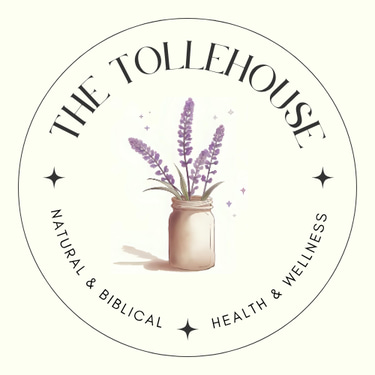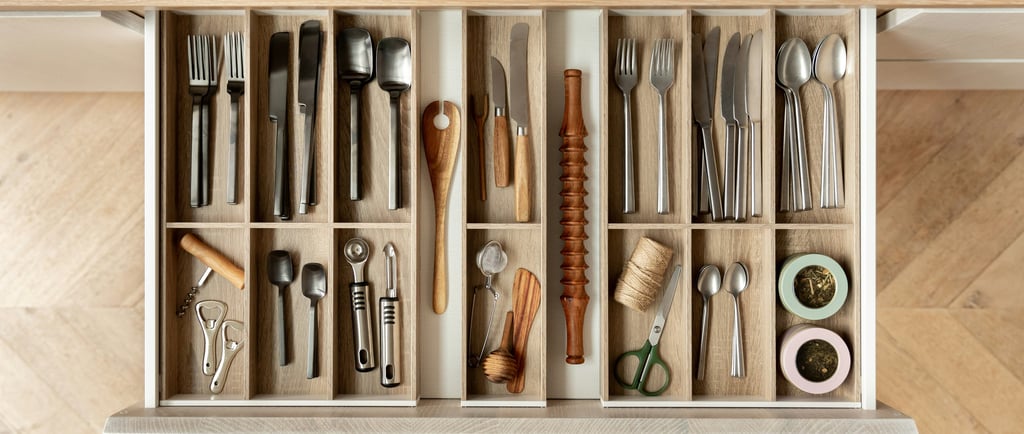

In late 2024, my husband was diagnosed with rheumatoid arthritis, a progressive autoimmune disorder that affects the joints and causes painful inflammation and swelling. When I learned this, I also discovered that one of the best remedies was to minimize inflammation and toxic input into his body. And that started in our kitchen.
The Problem with Plastic
Although plastic has been around for quite a while, dating back to about 1600 BC (I know, I am surprised too!), production really took off during and after World War II. Fast forward to the present, and just about everything is made of plastic, including common kitchen items such as spatulas, cutting boards, food storage containers, cups, plates, and more (Carbios). Although it's a convenient, cheap, and shatter-proof option for food storage and preparation, it's not without its flaws. Here are the top reasons I largely* don't use plastic items in my kitchen.
#1: Food Leaching
Plastic particles of various sizes leach into food from food storage, cutting boards, and plastic utensils; which means we are ingesting millions of them daily. In fact, Environmental Working Group estimates that "adults take in up to 150,000 plastic particles annually via their diet," which equates to up to 12 plastic bags per year. Of course, this includes sources like plastic water bottles and other things that are typically not in my kitchen, but the concept is the same. Plastic cutting boards are among the worst culprits, exposing us to plastic pieces that are still too small to see, but large enough to get into our food, cause gut inflammation, and even change the gut bacteria, as detailed in a very recent study.
#2: Endocrine, Immune System, and Gut Disruption
The chemicals found in plastics wreak havoc on the human body, even if we are largely asymptomatic. But have you ever thought that constant exposure to these toxins could be causing or exacerbating your health issues? These chemicals have been so heavily integrated into our lives that their safety of use isn't usually questioned. Here's an excerpt from the San Antonio Neuropathy Center:
What's My Solve?
No matter which way you cut it, plastic isn't very healthy for our bodies. It is made from artificial chemicals that harm our systems, and by using them daily, our bodies are under a lot of stress, even if we can't physically feel a difference. God designed our bodies to work hard 24/7 to constantly clean organs and remove toxins, but the amount of toxins we are exposed to in a day is more than you'd think. According to the San Antonio Neuropathy Center, we are exposed to anywhere between 700,000 to 2,100,000 toxins daily. That's insane! As an added note, many of those toxins are in the form of phthalates, polyphenols, polyethylene, PVC, PFAS, and other types of plastic.
So, what are the alternatives?
There are a lot out there from silicone, to wood, to metal, and more. But, to help narrow it down for you, these are the alternatives you'd find in my kitchen!
Glass Jars
Convenience: Not only are they great for canning, but quick and easy for food storage. It's easy to collect a lot of them...so don't fight it!
Freshness: I always know I'm getting a healthy, airtight seal when I use jars. In fact, plastic is porous on a microscopic level, so glass is a good alternative for that cardamom you used once for a recipe, and now want to store long-term.
Durability: Believe it or not, canning jars such as Ball or Kerr are actually pretty durable! Tested by a true klutz - I've dropped these from about four feet off the kitchen floor, and most of the time they won't even crack.
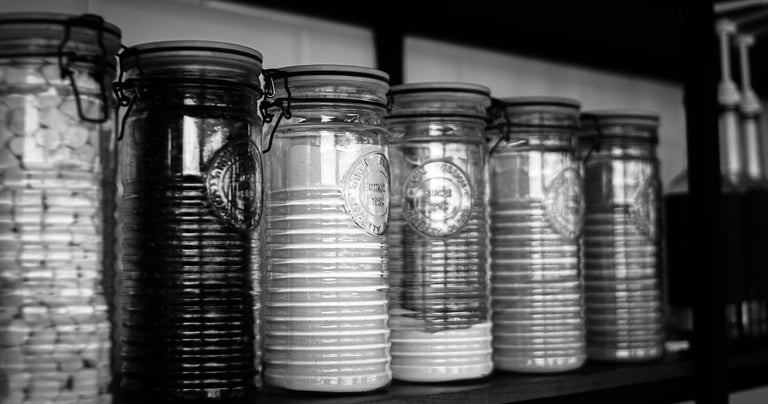

Wooden or Metal Utensils
Non-Leaching: When cooking with a metal or wooden spatula, I don't have to wonder if I will be having a serving of plastic with my bacon and eggs.
Durable: Unlike plastic (especially cheaply made cooking utensils), stainless steel or wood won't melt under intense heat.
Low Maintenance: Stainless steel is simple to wash with soapy water. Although wooden utensils require some occasional sterilizing and oiling to keep clean and sealed, I believe it's worth the extra effort. You can usually find a mineral oil at your local grocery store with instructions on how to seal your wooden utensils and cutting boards if you're not sure how.
Reusable Storage Bags
Freezer Safe: Food-grade silicone baggies are great for freezing meals and leftovers ahead. I even throw my vegetable scraps in them and make vegetable broth when I've accumulated enough!
Easy to Clean: Instead of tossing them, it's easy to wash them with soap and water, and then hang them upside down over a jar or mug to dry.
Commonly Sized: The baggies I use come in three different sizes--snack, sandwich and freezer--just like the big plastic brands!
Photo by Nahima Aparicio on Unsplash
Bamboo Cutting Board
For this change, I did quite a bit of research on having bamboo vs. metal vs. hardwood. Here's why I went with a bamboo cutting board:
Saves the knives: Metal and some types of hardwood will dull knives quickly with constant use, but bamboo is a slightly softer, more porous wood that is gentler on the sharp edges of a knife.
Cost effective: Woods like walnut, maple, and cherry can cost a lot. Bamboo is much cheaper, and requires a little extra cleaning and oiling once in a while, but I think it is worth the savings.
Cloth Napkins
Reusable: Cloth napkins are easy to wash with other kitchen towels and help to reduce waste.
Durable: These napkins stand up to messy barbecue ribs like no other! No need for multiple paper napkins to wipe any food off your face and hands.
Colorful: I have my multi-colored napkins displayed on the coffee table with alternating designs. Here are the two types I chose: Navy Blue and Orange Buffalo Plaid.
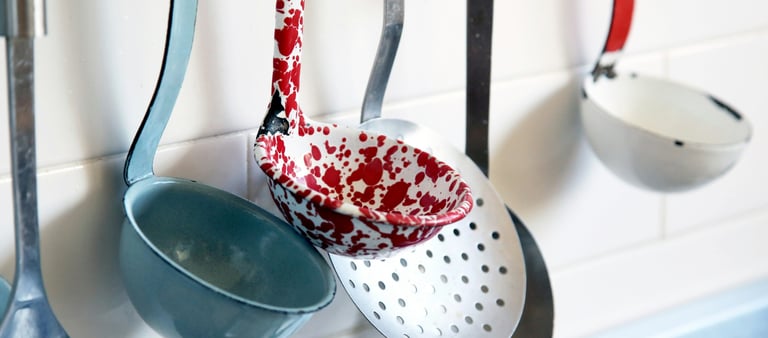


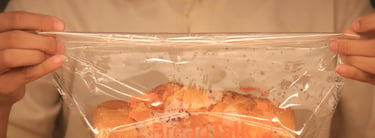
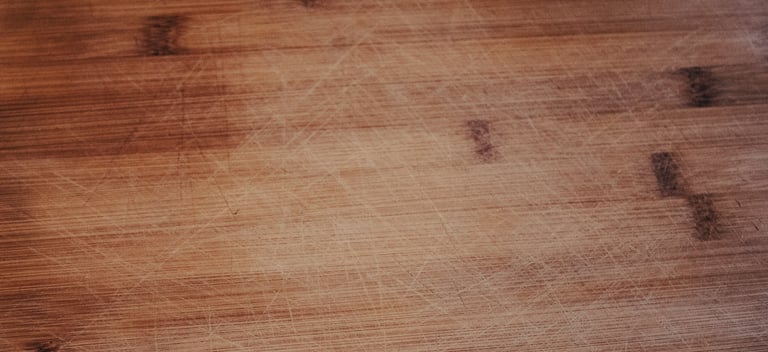

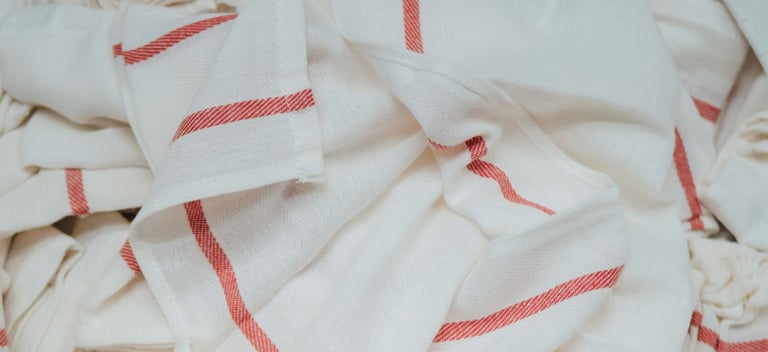

Photo by Mufid Majnun on Unsplash
Photo by Mufid Majnun on Unsplash
Photo by Shoaib Sheikh on Unsplash
Photo by Caroline Attwood on Unsplash
More Alternatives
Those were the biggest changes to my kitchen. I also swapped out my plastic 5-lb bucket for a galvanized metal one (for storing flour), my plastic silverware holder for a bamboo one, plastic cups and bowls for glass and ceramic, and I also changed out plastic wrap for unbleached parchment paper.
You can mix and match any of these ideas, or even come up with your own, but reducing the amount of toxic chemicals you and your family are exposed to is a sure benefit, no matter how much or how little you can do. Start small, and do what works best for your family!
Exceptions to the Rule
As I said in the beginning, I largely do not use plastic in my kitchen. Although I have invested a good bit time and money into changing the more important and most used kitchen items, I don't intend to switch out everything, simply because it would become too time-consuming and too expensive to maintain.
For example, I buy condiments and bagged food in plastic, and keep them that way until we finish them. If we go out to eat and I bring home leftovers in plastic, that's where they'll stay until I finish them all. I clean my cast-iron pans with a plastic scrubber brush for light-duty cleaning, but use a steel wool sponge for heavy-duty, extra crusty messes. And yes, I use soap.
Also, although the majority of my kitchen utensils are a mix of wood, metal, and silicone, I have a set of plastic baking spatulas that were gifted to my by my mother-in-law that I love using! (One of them even has measurement conversions on it - score!) And of course, if someone gifts me some food in a plastic container or baggie, I will not usually switch that out.
I also have a couple of plastic funnels, mostly because I haven't been able to find metal ones that have the skinny hole at the end. Silicone would be fine, but occasionally I'll do some canning, and I'd prefer the metal because I know for sure it will stand up to the heat.
Plastic is not something we can just eliminate from our lives, and it would be beyond exhausting to even try. I picked out some things I think are some of the easiest and the wisest to change, and it's been working great! I am not under pressure to go 100% non-toxic in my kitchen - although there are a number of other changes I made that aren't related to swapping out plastic specifically. And, I do admit, I felt a little crazy when I was pouring each of my seasonings into little glass jars. I was thinking, Am I going too far with this? I found that once I made the change, it put me at ease knowing that we were making healthier decisions for our family, one swap at a time. And if I have to be the crazy jar lady to do that, it's worth it!
